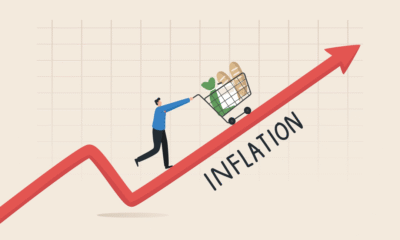Finance
Thailand’s Stock Market Plunge: Understanding the 16% Decline

Introduction to the Decline
The recent 16% decline in Thailand’s stock market has raised significant concerns among investors, businesses, and economic analysts alike. A stock market decline refers to a sustained decrease in the price levels of stocks on a stock exchange, which in this case represents a marked downturn in investor confidence and broader economic challenges. This sharp decline in Thailand’s stock market serves as a barometer reflecting not only the health of individual companies but also the overall economic landscape, including changes in consumer behavior, investor sentiment, and geopolitical events.
For investors, this downturn may result in diminished portfolio values, prompting re-evaluations of strategies and risk management practices. Businesses that rely on favorable market conditions for capital raising or expansions may face increased uncertainty, potentially leading to slower growth or, in some cases, scaled-back operations. The effects of such a decline can ripple through various sectors, impacting job creation, consumption, and overall economic stability. Investors and analysts must closely monitor these trends to anticipate further repercussions.
Several factors could contribute to such a notable drop in the stock market, including shifting monetary policies, global economic trends, and local political developments. Economic signals such as rising inflation, interest rate changes, and currency fluctuations can profoundly influence market dynamics. Furthermore, external factors like trade relationships and international investment flows are integral to understanding this decline. By exploring these influences, one can gain valuable insights into the specific reasons behind the current downturn in Thailand’s stock market and the implications it holds for the broader economy.
Historical Context of Thailand’s Stock Market
Understanding the historical performance of Thailand’s stock market is crucial for contextualizing the recent 16% decline. Since its inception in 1975, the Stock Exchange of Thailand (SET) has experienced notable fluctuations, reflecting both regional economic shifts and global market trends. The early years of the stock exchange were marked by modest growth, but the late 1980s and early 1990s saw a significant expansion, with a booming economy driving stock prices upward.
However, this period of prosperity was followed by the 1997 Asian financial crisis, which severely impacted the Thai stock market, leading to a drastic decline in share prices and market capitalization. The SET Index fell over 75% from its peak, illustrating the vulnerability of the market to external economic shocks. Following this tumultuous period, Thailand’s stock market showed signs of resilience, rebounding throughout the early 2000s, only to face challenges such as political instability and global recessionary pressures in subsequent years.
In the years leading up to the COVID-19 pandemic, the SET experienced a recovery, with increased foreign investment and a growing economy bolstering confidence among investors. Nevertheless, the pandemic brought unprecedented challenges, causing another significant decline in stock values. The market has since gradually rebounded, yet the recent 16% decline is a reminder of the stock market’s cyclical nature and its susceptibility to both domestic and international factors.
Comparing the current downturn to past significant declines reveals an important narrative about the resilience of Thailand’s stock market. Historical patterns of recovery often follow periods of economic hardship, suggesting that while the current climate presents challenges, historical evidence supports the notion that the market can and often does recover over time.
Key Factors Behind the Decline
The recent 16% decline in Thailand’s stock market has been influenced by a combination of both external and internal factors. A primary external influence has been the challenging global economic landscape. As major economies continue to grapple with rising inflation rates and interest rate adjustments, market investors are experiencing increased volatility. The tightening of monetary policies in key countries, particularly the United States, has led to reduced liquidity, prompting a cautious approach by foreign investors towards emerging markets, including Thailand.
Geopolitical tensions have also played a crucial role in shaping investor sentiment across the region. Ongoing conflicts and uncertainty in neighboring countries can lead to concerns about stability and economic growth in Thailand. Such geopolitical factors often cause investors to adopt a ‘wait and see’ attitude, further increasing the downward pressure on the stock market.
In addition to these external influences, there are significant internal factors contributing to the decline. Recent domestic policy changes, particularly those affecting key sectors like tourism and exports, have raised concerns among investors about the future economic outlook. The Thai government’s efforts to stimulate the economy through various initiatives have not yet resulted in the anticipated positive impacts, leading to skepticism amongst market participants.
Further compounding this situation are recent economic indicators that reflect a downturn. For instance, data revealing lower consumer spending and weak industrial output have diminished market confidence. These economic challenges have contributed to a negative sentiment, making it difficult for the stock market to stabilize.
Ultimately, the 16% decline in Thailand’s stock market can be attributed to a complex interplay of global economic pressures, geopolitical factors, and domestic policy evaluations, all of which continue to shape investor behavior.
Impact on Investors
The recent 16% decline in Thailand’s stock market has sent ripples through the investment community, affecting various types of investors. Retail investors, often characterized by individual, small-scale participation in the market, typically react more emotionally to market fluctuations. The sudden plunge can trigger panic selling, as these investors may feel the immediate pressure to salvage their investments. Retail investors often lack the resources to undertake thorough analysis during turbulent times, which may further exacerbate their emotional responses, leading to impulsive decisions that can ultimately result in substantial losses.
Institutional investors, on the other hand, have access to extensive research and analytical resources, allowing them to assess market conditions more objectively. Their reaction to market downturns can vary significantly from that of retail investors. While some institutional investors may take advantage of the dip to acquire undervalued stocks, others might implement risk management strategies to mitigate potential losses. This could involve reallocating their portfolios to less volatile assets or engaging in hedging strategies aimed at capital preservation.
International investors are also affected by domestic market fluctuations. A decline in the Thai stock market can deter foreign investments, as investors often calculate the risk-to-reward ratio based on current market conditions. This could lead to capital outflows, further exacerbating the market decline. However, savvy international investors may view this as an opportunity to enter the market at a lower price point, considering the long-term potential of Thailand’s economic recovery.
Overall, investor sentiment during such a significant market downturn is influenced by psychological factors, including fear and uncertainty. Anticipating a prolonged decline can lead to heightened anxiety among investors. Yet, by focusing on strategic approaches—whether through panic selling or opportunistic buying—investors can navigate these challenging times while considering both individual risk tolerance and long-term investment goals.
Sector-specific Effects
The recent 16% decline in Thailand’s stock market has reverberated across various sectors, each experiencing unique ramifications. Generally, sectors such as tourism and exports have faced the most significant impacts. The Thai tourism industry, which is a crucial contributor to the economy, has seen a sharp decrease in foreign visitors due to travel restrictions and global economic uncertainties. This downturn not only affects hotel and restaurant revenues but also has a cascading effect on sectors like transportation and retail that rely heavily on tourism-related activities.
Exports, another vital pillar of the Thai economy, are similarly feeling the strain. The demand for Thai goods, particularly in the manufacturing sector, has slowed due to heightened competition and changing trade dynamics in the global market. Industries such as electronics, automotive parts, and agricultural products have experienced fluctuations in orders, leading to a decrease in production and job losses. Manufacturers are facing pressure to adapt to the evolving global economy, which can lead to innovations but also increased operational risks.
Conversely, some sectors appear to show potential for recovery amid the overall market decline. The technology sector, particularly those involved in digital services and e-commerce, is experiencing a surge in demand as consumer behaviors shift towards online platforms. This transformation is paving the way for growth in companies that can provide innovative solutions and capitalize on the digital economy. The healthcare sector is also gaining traction, with a growing emphasis on medical services and pharmaceutical products in response to heightened health consciousness influenced by recent global events.
In summarizing the effects of the stock market plunge, it is clear that while tourism and exports suffer significantly, sectors like technology and healthcare may offer pathways for resilience and recovery in the Thai economy. Monitoring these sector-specific outcomes will be vital as investors and policymakers formulate strategies to navigate the ongoing challenges within Thailand’s market landscape.
Comparative Analysis with Other Markets
The recent 16% decline in Thailand’s stock market has raised significant questions regarding the unique nature of this downturn and its effects in the context of broader Southeast Asian markets. To fully grasp the implications of this drop, a comparative analysis with the performance of neighboring countries is crucial. Several Southeast Asian economies are also contending with various challenges, such as inflationary pressures, currency fluctuations, and geopolitical tensions, creating a complex landscape for investors.
For instance, Indonesia’s stock market has displayed resilience amid external pressures, benefiting from strong commodity exports, which have helped sustain prices and bolster investor confidence. Despite facing some headwinds, such as inflation and labor disputes, Indonesia’s economic fundamentals show relative strength compared to Thailand’s ongoing struggles with political instability and economic reform failures that have hindered investor sentiment.
Similarly, Malaysia’s stock indices have experienced fluctuations corresponding to global economic trends, but it has fared better than Thailand in various sectors, particularly in technology and finance. The recovery efforts in Malaysia, supported by active government interventions and incentives, have attracted foreign investments, contrasting starkly with Thailand’s investment climate, where uncertainty appears to deter potential capital inflow.
Moreover, the Philippines has also demonstrated growth amid regional challenges, with its stock market reflecting a positive outlook driven by domestic consumption and remittance inflows. The resilience of other Southeast Asian markets may suggest that Thailand’s decline is part of a more extensive regional adjustment rather than an isolated incident. Observing these dynamics reveals the interconnectedness of economies within Southeast Asia, allowing for a more nuanced understanding of Thailand’s stock market performance and emphasizing the significance of regional economic factors.
Government and Regulatory Responses
The recent 16% decline in Thailand’s stock market has prompted urgent responses from both the Thai government and financial regulatory bodies. To mitigate the impact of this downturn, the government has implemented various policy measures aimed at stabilizing the economy and restoring investor confidence. One of the primary focuses has been on enhancing liquidity in the market. This has involved the introduction of fiscal stimulus packages designed to support businesses that are experiencing financial strain as a result of the market’s decline.
Additionally, the government is considering tax incentives for investors, particularly those who invest in critical sectors such as technology and renewable energy. These measures aim to incentivize capital inflow and boost investor sentiment, which has been shaken by recent market volatility. Moreover, discussions around revising regulatory frameworks to ensure greater transparency and accountability among publicly listed companies are also underway. By reinforcing these regulations, the government hopes to enhance trust among stakeholders in the stock market.
Furthermore, the Securities and Exchange Commission (SEC) of Thailand has taken a proactive role in this situation by implementing actions to protect investors. These include tightening rules for public offerings and bolstering the enforcement of insider trading laws. The SEC is also working on various investor education initiatives aimed at equipping investors with knowledge and strategies to navigate the current market landscape effectively.
Support programs have been developed to assist small and medium-sized enterprises (SMEs), which are vital to the Thai economy. The government has initiated credit facilities aimed at providing financial assistance to these businesses during the downturn. By fostering a supportive environment for SMEs, Thailand aims to ensure economic resilience in the face of market challenges. Through these collective efforts, the Thai government and regulatory bodies are striving to lay the groundwork for recovery and future market stability.
Long-term Outlook and Recovery Strategies
The recent 16% decline in Thailand’s stock market has raised significant concerns regarding the long-term implications for the country’s economy. As investors and businesses assess the situation, it is crucial to consider potential recovery strategies that can mitigate risks. Experts predict that while the immediate effects of the market plunge may be daunting, the underlying fundamentals of the Thai economy can provide a foundation for sustained recovery.
One potential strategy for investors is to diversify their portfolios. By broadening investments across different sectors, both domestic and international, individuals can better protect themselves against volatile market conditions. This approach not only helps in risk management but also opens up opportunities in potentially lucrative markets that may benefit from an economic recovery.
Corporate entities are also encouraged to conduct thorough risk assessments and adjust their strategic plans accordingly. Implementing cost control measures, optimizing supply chains, and exploring new revenue streams can position businesses to not only weather the storm but emerge stronger in a post-recovery scenario. Embracing technology and innovation will be key drivers for operational efficiency in this context.
It is essential for stakeholders to remain informed about economic indicators that signal recovery. Factors such as consumer confidence, inflation rates, and foreign investment flows will play pivotal roles in determining the pace at which the market stabilizes. Furthermore, government policies designed to bolster economic growth, such as fiscal stimulus and infrastructure development, could significantly impact overall market sentiment.
In conclusion, while the 16% decline in Thailand’s stock market is a cause for concern, understanding the long-term outlook and adopting effective recovery strategies can help mitigate risks. By diversifying investments, optimizing operational strategies, and staying attuned to economic indicators, both investors and businesses can navigate through these challenging times and position themselves for future growth.
Conclusion: Navigating Future Uncertainties
The recent 16% decline in Thailand’s stock market serves as a stark reminder of the volatility that can characterize financial markets. Throughout this discussion, we have analyzed the multifaceted causes of this significant drop, including global economic pressures, domestic political uncertainties, and external market influences. Understanding these factors is crucial, as they not only shape investor sentiment but also define the broader economic landscape in which investments will flourish or falter.
As we look toward the future, staying informed is paramount for both seasoned and novice investors. Engaging with reliable sources of information, such as financial news outlets, market analysis reports, and expert insights can help individuals make more informed decisions. Moreover, adapting one’s investment strategy to recognize shifting trends and emerging opportunities is essential in navigating such tumultuous periods. Diversification remains a pivotal tactic for mitigating risks—securing investments across various sectors can cushion portfolios against sharp downturns while retaining exposure to potential growth areas.
Investors are encouraged to maintain a proactive approach, striking a balance between vigilance over economic indicators and a willingness to embrace potential benefits found within market fluctuations. The current landscape presents unique challenges, but it also unveils opportunities for those ready to seize them. By cultivating a well-rounded perspective on the risks and rewards associated with Thailand’s stock market and keeping an eye on both local and global economic developments, investors can better position themselves for successful outcomes. Ultimately, navigating this uncertain environment will require a commitment to ongoing education, strategic adaptation, and prudent decision-making.
Investing
Global Investor Outflows from U.S. Stocks & Dollar

In a shift that is sending ripples across financial markets, institutional investors around the world are pulling back from U.S. equities and reducing exposure to the U.S. dollar, signaling a significant change in sentiment toward American assets. According to the latest Bank of America Global Fund Manager Survey, global investors are now the most underweight on U.S. stocks in more than two decades, with the dollar facing similar skepticism as a long-term safe-haven asset. This transition is being fueled by multiple converging factors, including geopolitical instability, growing U.S. fiscal deficits, trade tensions, and an increasingly favorable investment climate in Europe and select emerging markets. For investors, economists, and policymakers alike, this trend represents a rebalancing of global capital flows that could reshape market dynamics in the months ahead.
Investor Sentiment Toward U.S. Markets Hits Multi-Year Lows
The Bank of America survey, considered a key barometer of global institutional sentiment, reveals that fund managers have turned heavily underweight on U.S. stocks and the dollar, preferring instead to rotate their portfolios into European and Asian equities. The survey showed that 36% of participants are now net underweight U.S. equities—the highest level since 2003. At the same time, positioning on the dollar turned net negative for the first time in over five years, with investors citing mounting fiscal concerns, valuation extremes, and weakening macroeconomic indicators.
The U.S. equity market, especially the tech-heavy NASDAQ, has experienced an extraordinary bull run over the last several years. But now, investors are questioning the sustainability of elevated valuations, particularly as economic growth slows, earnings forecasts are revised downward, and inflation remains persistently above target. Many portfolio managers believe the best returns may no longer be found in U.S. assets alone.
Rising U.S. Debt and Fiscal Deficits Raise Red Flags
A key driver of investor caution is the ballooning U.S. fiscal deficit. The Congressional Budget Office (CBO) projects that the U.S. federal deficit will reach over $1.8 trillion this year, driven by increased government spending, rising interest costs, and lower-than-expected tax revenues. The national debt is now projected to exceed 125% of GDP by 2030, raising serious questions about long-term fiscal sustainability.
Investors fear that soaring U.S. debt levels could lead to a loss of confidence in Treasury securities, pushing yields higher and triggering volatility in global credit markets. This concern is magnified by the growing political polarization in Washington, which has led to repeated debt ceiling standoffs and policy gridlock. As a result, some asset managers are choosing to diversify their bond portfolios with sovereign debt from countries like Germany, Canada, and Australia—nations viewed as having stronger fiscal discipline.
Geopolitical Tensions Erode Dollar Safe-Haven Appeal
The traditional role of the U.S. dollar as a global safe-haven currency is also being called into question. With the U.S. now embroiled in rising geopolitical conflicts, including its military engagement in the Middle East and an escalating trade war with China, the perception of the dollar as a “neutral” or stable currency is beginning to fade. Several countries, particularly in the Global South, have voiced frustration over the dominance of the dollar in international trade, and some have even accelerated efforts to settle trade in alternative currencies such as the euro, yuan, or local currency blocs.
In response, central banks in emerging markets are reducing their U.S. dollar reserves and increasing holdings in gold and non-dollar currencies. This trend, while gradual, is gaining momentum and contributing to the dollar’s underperformance against a basket of global currencies. The U.S. dollar index (DXY) has declined by nearly 6% year-to-date, reflecting both diminished investor confidence and a broader reconfiguration of reserve management strategies.
Attractive Valuations Abroad Drive Capital Outflows
While risks in the U.S. are mounting, attractive investment opportunities abroad are also contributing to the outflow of capital from American markets. European equities, particularly in sectors like green energy, luxury goods, and financial services, are seeing renewed interest thanks to relatively low valuations and improving macroeconomic stability. The recent ECB rate cuts and Eurobond discussions have added to optimism about the region’s fiscal and financial integration.
In Asia, countries like India, Indonesia, and Vietnam are emerging as new hotspots for foreign direct investment and equity inflows. These economies offer robust growth prospects, younger demographics, and increasingly tech-driven industries. Additionally, Japan’s bond market is seeing increased institutional buying, as long-term yields rise in response to the Bank of Japan’s policy changes.
This global diversification strategy is not just about seeking higher returns—it’s also about managing risk. Investors are increasingly looking to balance their portfolios geographically, reducing dependence on any single region and hedging against macroeconomic shocks that may be specific to the U.S.
Currency Hedging and Diversification as Defensive Strategies
In response to the dollar’s volatility, many fund managers are now engaging in currency hedging strategies to protect their portfolios. Currency ETFs, options, and forward contracts are being used to minimize the downside risk of a weakening dollar. At the same time, global investment funds are ramping up their exposure to non-dollar-denominated assets, including eurozone corporate bonds, emerging market debt, and local-currency sovereign issues.
Moreover, ESG and green bond markets in Europe and Asia are attracting capital due to their alignment with global sustainability goals. These instruments not only offer diversification but also align with broader institutional mandates on responsible investing.
Implications for U.S. Markets and Monetary Policy
The capital flight from U.S. assets could have significant implications for American markets. A persistent decline in foreign demand for U.S. Treasuries may force the Federal Reserve to intervene more frequently in the bond market to maintain liquidity and control yields. At the same time, a weaker dollar could contribute to imported inflation, complicating the Fed’s efforts to bring core inflation back within its target range.
On the equities side, if investor outflows persist, U.S. companies may face higher capital costs and declining valuations, particularly in sectors that rely heavily on foreign investment or exports. Domestic pension funds and institutional investors may need to fill the gap left by global investors, which could further alter asset allocation strategies and influence corporate financing decisions.
A New Era of Global Capital Rotation
The growing shift away from U.S. stocks and the dollar signals the beginning of a new era in global investing, one defined by diversification, geopolitical hedging, and currency rebalancing. While the U.S. remains a central player in global finance, the days of unquestioned dominance are beginning to fade, as investors embrace a more nuanced and distributed view of risk and opportunity.
For market participants, staying agile in this environment means tracking global fund flows, monitoring geopolitical developments, and reassessing the traditional U.S.-centric portfolio model. As capital continues to flow into European and Asian markets, the future of global finance is being rewritten—and those who adapt early may find themselves ahead of the curve.
Finance and Economy
France Pushes Eurozone Toward Joint Eurobond Issuance

In a bold move that could redefine the financial architecture of the European Union, France has renewed its push for the issuance of joint eurozone debt instruments – commonly referred to as Eurobonds – as a way to strengthen the euro on the global stage. As the EU prepares for its upcoming summit on June 26-27, the proposal is once again stirring heated debate among member nations. French officials argue that a shared debt mechanism is essential not only for financial resilience but also for elevating the euro’s standing as a credible alternative to the U.S. dollar. While the idea garners support from key institutions like the IMF and the ECB, resistance from fiscally conservative member states continues to block consensus. This article explores the implications of France’s proposal, the potential benefits and challenges of Eurobond issuance, and the evolving role of the euro in a multipolar financial world.
France’s Strategic Case for Eurobonds
French President Emmanuel Macron and Finance Minister Bruno Le Maire have long been advocates for deeper EU financial integration. According to them, Eurobonds would represent a tangible step toward fiscal solidarity and monetary cohesion, allowing member nations to borrow at collectively favorable rates while demonstrating political unity. The latest push comes at a time when the European economy is facing several headwinds: slowing growth, fragmented recovery across member states, and heightened global financial volatility triggered by geopolitical conflicts and energy insecurity. Macron has reiterated that a common debt tool is essential for financing major EU-wide projects such as green energy transition, digital infrastructure, and military defense.
From a strategic standpoint, France views Eurobonds as more than just a financial mechanism – they are a symbol of EU credibility and resilience. By pooling risk and aligning borrowing capacity, the eurozone could present a united front in capital markets, reducing the vulnerability of weaker economies and improving the euro’s attractiveness to foreign investors.
The Euro’s Current Global Standing and Its Challenges
Despite being the world’s second most-used currency, the euro still lags far behind the U.S. dollar in terms of global reserve share, trade settlement, and safe-haven preference. Analysts point out that one of the primary reasons for this is the fragmented nature of the eurozone bond market. Each country issues its own sovereign debt, leading to a lack of a single, risk-free eurozone bond benchmark – unlike U.S. Treasuries, which offer deep liquidity and low risk.
France’s proposal seeks to address this imbalance. A unified Eurobond market could create a highly liquid, stable, and scalable financial product that would attract central banks, pension funds, and sovereign wealth investors. Over time, this could shift more global reserves into euros, boosting the currency’s influence in global trade and finance.
Institutional Support: IMF, ECB, and Market Participants
Key international organizations have thrown their weight behind the idea. The International Monetary Fund (IMF) has suggested that Eurobonds could enhance the EU’s fiscal capacity and crisis response agility. Meanwhile, European Central Bank (ECB) officials, including President Christine Lagarde, have hinted that deeper fiscal integration is necessary for the euro to realize its full potential.
Financial market participants have also shown interest. Asset managers argue that Eurobonds could become a cornerstone of fixed-income portfolios, particularly for investors looking to diversify away from dollar-denominated assets. Some analysts compare the opportunity to the creation of the U.S. Treasury market in the post-war era, which laid the groundwork for the dollar’s global dominance.
Opposition from the Frugal Four and Risk-Sharing Concerns
Despite France’s enthusiasm and institutional support, significant opposition persists from fiscally conservative EU nations, notably Germany, Austria, the Netherlands, and Finland—often dubbed the “Frugal Four.” These countries argue that shared debt would penalize responsible fiscal behavior and open the door to moral hazard, where weaker economies might overborrow under the protection of joint guarantees.
German officials have also cited constitutional constraints and public opposition to any perceived “debt mutualization.” Instead, they advocate for reforms at the national level, more stringent budget controls, and the use of existing mechanisms like the European Stability Mechanism (ESM) for crisis funding.
This divide continues to stall formal negotiations. At the heart of the debate is the question of trust and fiscal governance, as many northern states remain skeptical about the long-term commitment of their southern counterparts to austerity and budget discipline.
Implications for Financial Markets and Investors
If approved, Eurobonds would be a game-changer for European capital markets. They would offer a new safe asset class, potentially rivaling U.S. Treasuries in size and reliability over the long term. For the European banking system, Eurobonds could provide high-quality collateral and improve liquidity conditions, especially for cross-border lending.
Investors are closely monitoring the situation. If the EU takes concrete steps toward joint bond issuance, bond yields across peripheral economies like Italy, Spain, and Greece could compress further, as risk premia shrink in anticipation of shared guarantees. Simultaneously, euro-denominated assets may see a surge in foreign inflows, especially from central banks seeking to rebalance reserve portfolios.
Strengthening the Euro’s Role in a Multipolar World
The geopolitical landscape is increasingly defined by multipolarity, with China, Russia, and the U.S. competing for influence in trade, finance, and security. In this context, the eurozone faces a historic opportunity to carve out a more assertive role. Strengthening the euro through fiscal and capital market integration is seen as essential to counterbalance the dollar’s dominance and reduce reliance on U.S.-led financial infrastructure.
Eurobonds could serve as a financial pillar in this transition. As global investors seek alternatives in a fragmented world economy, the euro’s rise as a stable, investable, and liquid currency backed by joint instruments could bolster its credibility and utility.
A Defining Moment for European Unity
France’s push for Eurobonds is more than just a fiscal proposal – it is a call for political and financial unity in a time of global uncertainty. While the road to consensus is steep, the growing support from institutions, investors, and southern EU members suggests that momentum is building. The upcoming EU summit will be a crucial test of the bloc’s ability to move beyond national interests and toward a shared financial future.
If successful, Eurobond issuance could redefine the eurozone’s role in the global economy, offering new tools for crisis response, economic development, and financial competitiveness. For investors and policymakers alike, this moment marks a critical juncture – either Europe seizes the opportunity to lead, or it risks remaining a secondary player in a rapidly evolving financial world.
Finance and Economy
Oil Price Spike as Middle East Conflict Deepens: A Global Market Wake-Up Call

The financial world is once again on high alert as escalating tensions in the Middle East have triggered a sharp surge in global oil prices, sending shockwaves through equity, commodity, and currency markets alike. With the U.S. reportedly striking Iran’s nuclear sites, Brent crude surged over 18%, nearing $80 per barrel in a matter of hours. The sudden volatility reignited fears of a potential $100 oil scenario, reminiscent of past geopolitical flashpoints that deeply impacted global supply chains, inflation expectations, and central bank policy stances. This article delves into the causes, consequences, and global financial implications of this emerging crisis.
The Trigger: U.S. Strikes on Iran’s Nuclear Infrastructure
On June 21, 2025, international news outlets confirmed that U.S. military forces had targeted Iranian nuclear facilities in what they described as a “pre-emptive defensive measure.” While the full extent of the damage is still being assessed, the attack has clearly escalated tensions in an already volatile region. The Middle East, being a vital hub for global oil production and shipping, plays a significant role in maintaining supply stability. Iran, which controls access to the Strait of Hormuz – a key chokepoint through which nearly 20% of the world’s oil supply passes—responded with threats to close the strait and intensify its military posturing. This heightened the risk premium in energy markets virtually overnight.
Oil Prices React Swiftly to Geopolitical Instability
Crude oil, especially Brent and West Texas Intermediate (WTI), reacted with extreme sensitivity to the developments. Brent crude jumped over 18% within a 24-hour period, while WTI saw a comparable surge. Analysts at Goldman Sachs and JPMorgan warned that if the Strait of Hormuz were to be blocked, prices could surpass $100 per barrel within weeks. The last time the oil market saw such an intense geopolitical premium was during the 2019 drone attacks on Saudi oil facilities. However, the current situation has a more severe undertone due to the involvement of nuclear assets and direct military strikes between two powerful adversaries.
Safe Haven Assets Soar as Risk Appetite Declines
As is common in times of geopolitical crisis, investors flocked to safe-haven assets such as gold, the U.S. dollar, and U.S. Treasuries. Gold climbed above $2,400 per ounce, a level not seen in years, while the U.S. dollar index rose nearly 2% as capital fled emerging markets and riskier assets. Meanwhile, 10-year U.S. Treasury yields fell sharply, reflecting a surge in demand for perceived low-risk instruments. Cryptocurrency markets, particularly Bitcoin, experienced a brief rally as some investors viewed digital assets as alternative stores of value, although that rally quickly reversed amid broader market instability.
Stock Markets Face Broad Sell-Off, Led by Energy-Sensitive Sectors
Equity markets around the globe responded negatively. The S&P 500 and NASDAQ both dropped over 2.5% in intraday trading, led by declines in consumer discretionary, industrials, and airline stocks, which are highly sensitive to fuel price increases. European indices such as the FTSE 100 and DAX also saw steep losses, while Asia-Pacific markets like the Nikkei 225 and Hang Seng Index fell sharply as investors priced in a higher global risk premium. Interestingly, energy stocks provided the only bright spot in an otherwise red sea of market activity, with companies like ExxonMobil and Chevron posting strong gains on expectations of rising revenues.
Inflationary Pressures Could Derail Central Bank Strategies
The surge in oil prices couldn’t have come at a worse time for global central banks. After years of battling inflation through aggressive interest rate hikes, many central banks had only just begun to pause or consider rate cuts in 2025. However, higher energy prices feed directly into inflation, particularly in transport, manufacturing, and agriculture sectors, potentially forcing monetary authorities to reverse their dovish pivot. The European Central Bank (ECB), which had recently initiated its first rate cut in years, may now face pressure to hold off on further easing. Similarly, the Federal Reserve, which had opted to maintain its current rate in the last FOMC meeting, is likely to adopt a more hawkish tone moving forward.
Emerging Markets Bear the Brunt of the Crisis
The fallout from spiking oil prices is especially damaging for emerging markets, which are typically more sensitive to commodity price fluctuations. Countries like India, Turkey, and South Africa, which are major oil importers and have significant current account deficits, saw their currencies depreciate against the dollar. This adds to inflationary pressures and increases the cost of dollar-denominated debt, complicating fiscal and monetary policy responses. Foreign institutional investors also withdrew capital from these markets, adding to equity market stress and further depressing sentiment.
Global Economic Growth at Risk
Economists are revising down global GDP forecasts amid fears that higher oil prices will dampen consumer spending, elevate production costs, and destabilize corporate earnings. According to the IMF, a sustained oil price above $90 could reduce global GDP growth by 0.5% annually, with some regions like Southeast Asia and Sub-Saharan Africa experiencing even greater negative impacts. Supply chains, already recovering from post-pandemic disruptions and trade tensions, now face renewed uncertainty due to potential shipping bottlenecks in the Persian Gulf.
Outlook: What Comes Next for Markets and Policymakers?
Going forward, much depends on how the situation in the Middle East evolves. A de-escalation through diplomatic channels, possibly via UN or EU mediation, could stabilize oil prices and soothe market nerves. On the other hand, if Iran follows through on its threat to block the Strait of Hormuz or retaliates militarily, the crisis could escalate into a full-blown regional conflict with severe repercussions for global trade and energy supply. Policymakers worldwide are monitoring the situation closely, and emergency meetings by OPEC and G20 finance ministers are already being planned. The International Energy Agency (IEA) has also signaled its willingness to release strategic petroleum reserves if needed to calm markets.
The Road Ahead is Uncertain but Manageable
In the face of rising geopolitical tensions and economic uncertainty, investors are advised to adopt a cautious, diversified approach. While markets remain volatile and unpredictable, sound investment principles – such as maintaining a balanced portfolio, avoiding over-leveraged positions, and focusing on long-term fundamentals – remain more relevant than ever. The oil price spike triggered by the U.S.-Iran conflict is a potent reminder of how global politics and finance are deeply intertwined, and why staying informed and agile is critical in today’s interconnected world.
-

 Finance & Investment6 months ago
Finance & Investment6 months agoEmerging Markets to Watch in 2025: Opportunities and Risks
-

 Technology and Finance8 months ago
Technology and Finance8 months agoThe Future of Quantum Computing in Financial Modeling and Trading
-

 Finance7 months ago
Finance7 months agoUSA Market Trends & Global Finance Insights
-
Finance7 months ago
Navigating Retirement in the Gig Economy: Challenges and Solutions
-

 Finance8 months ago
Finance8 months agoNavigating Personal Finance in the Age of Inflation and High Interest Rates
-

 Economics6 months ago
Economics6 months agoGlobal Markets React to U.S. GDP Contraction: A Comprehensive Analysis
-

 Investing & Finance8 months ago
Investing & Finance8 months agoFractional Investing: The Path to Wealth Democratization
-

 Finance7 months ago
Finance7 months agoTop 10 High-Yield Savings Accounts in the US (2025 Edition)








